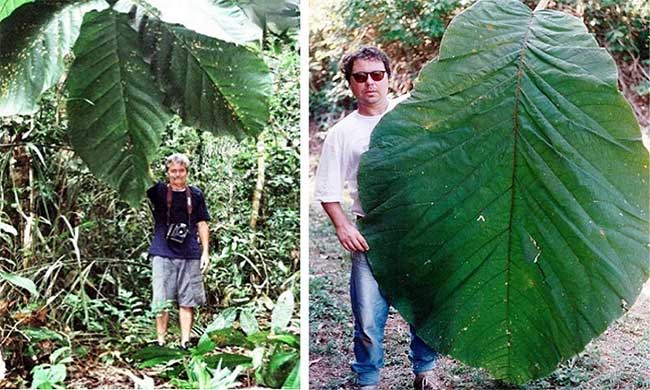Amazon forest trees have longer leaves than adults
Coccoloba gigantifolia grows 15 meters tall, has 2.5 meter long leaves, most likely the largest leafy species of the dicotyledonous plants.
A team of botanists at the Amazon Research Institute (INPA) in Manaus discovered a new plant in the Coccoloba genus in the American rainforest. They first encountered Coccoloba trees in 1982 while surveying the Madeira River basin. They later found more individuals on expeditions in the 1980s but could not identify the species.

Coccoloba leaf gigantifolia.(Photo: Mongabay).
The tree is found without flowers or fruits. Their leaves are too large to dry, pressed or brought back to INPA. The team was forced to take notes and take photographs as documentation. In 1993, botanists collected two large leaves from an individual tree in Rondônia state for framing at INPA. However, due to the lack of a reproductive unit, Rogério Gribel, an INPA researcher, and his colleagues could not describe it as a new species.
In 2005, Gribel and his colleague Carlos Alberto Cid Ferreira gathered some seeds from an individual tree in Jamari National Forest. They planted the seed in the courtyard and it took 13 years to get results. In 2018, one of the plant samples grew and blossomed, providing the necessary data for researchers. Gribel and his colleagues named it Coccoloba gigantifolia based on its huge leaf size in research published in the journal Acta Amazonica.
According to them, C. gigantifolia is rare and at high risk of extinction. These individuals were only recorded from the Madeira river basin of Amazonas and Rondônia states, which are affected by infrastructure projects such as hydroelectric dam construction, road construction and agricultural expansion. Due to these risks, the study team recommends that C. gigantifolia be listed as endangered in the International Union for Conservation of Nature's Red List (IUCN).
- Amazon forests are being destroyed at an unprecedented speed in the last 10 years
- Shocking photos of the Amazon forest burst into record speed
- Terrible mysteries in the Amazon jungle
- Beautiful Amazon natural forest comes to awe
- Peru warns that the Amazon rainforest is destroyed at a rapid rate
- Terrible consequences of the Amazon forest fire
- Forest fires and droughts can destroy the Amazon forest
- Drought threatens Amazon carbon sinks
- Why does the Amazon River longer than 6,000km without a bridge spanning?
- Amazon forest has many bustling cities
- Watch out for the animals that died when the Amazon forest was visited by the 'firewoman'
- Amazon Forest: Discovering an unbelievably strange fish species
 Why do potatoes have eyes?
Why do potatoes have eyes? 'Tragedy' the world's largest carnivorous life: Death becomes ... public toilet
'Tragedy' the world's largest carnivorous life: Death becomes ... public toilet Tomatoes were once considered 'poisonous' for 200 years
Tomatoes were once considered 'poisonous' for 200 years Detecting microscopic parasites on human face
Detecting microscopic parasites on human face